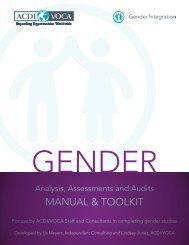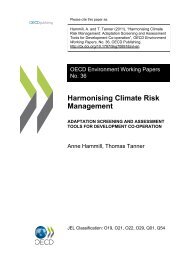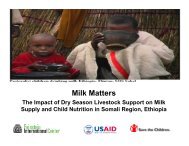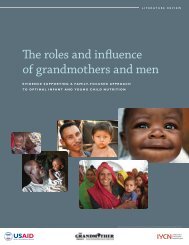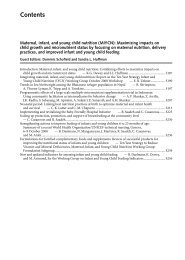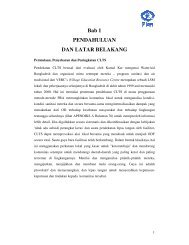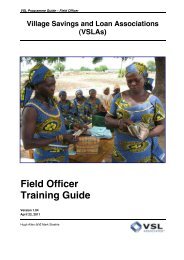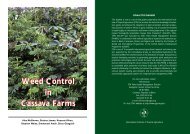Gender and climate change research in - FAO
Gender and climate change research in - FAO
Gender and climate change research in - FAO
Create successful ePaper yourself
Turn your PDF publications into a flip-book with our unique Google optimized e-Paper software.
etween gender, <strong>climate</strong> <strong>change</strong> <strong>and</strong> food security. In Part II, Modules 4–7 outl<strong>in</strong>e a <strong>research</strong> effort<br />
designed to address three particular <strong>research</strong> topics of <strong>in</strong>terest to the CCAFS program: <strong>climate</strong><br />
analogues, weather <strong>in</strong>formation, <strong>and</strong> <strong>climate</strong>-smart agriculture. These refer to three <strong>in</strong>tervention<br />
areas that CCAFS has prioritized <strong>in</strong> its <strong>in</strong>itial stages, <strong>and</strong> is conduct<strong>in</strong>g <strong>research</strong> on <strong>in</strong> order to test<br />
some of the approaches described <strong>in</strong> Part 1. The objectives of this learn<strong>in</strong>g approach are to: 1) see<br />
how well the tools help us address complex gender <strong>and</strong> social-differentiation questions related to<br />
these potential areas of <strong>in</strong>tervention, <strong>and</strong> 2) to generate <strong>research</strong> results that will <strong>in</strong>form <strong>and</strong> improve<br />
the design of future CCAFS <strong>and</strong> partner <strong>research</strong> <strong>and</strong> development efforts. Part II provides important<br />
<strong>in</strong>formation on how to rigorously implement these <strong>research</strong> tools, use a sampl<strong>in</strong>g strategy, <strong>and</strong> th<strong>in</strong>k<br />
about analysis <strong>and</strong> report<strong>in</strong>g on the f<strong>in</strong>d<strong>in</strong>gs from such approaches right from the beg<strong>in</strong>n<strong>in</strong>g of study<br />
plann<strong>in</strong>g. It is hoped that this example will help (<strong>and</strong> <strong>in</strong>deed, be used by) future study teams that may<br />
have additional <strong>research</strong> questions, as the same framework can be applied <strong>and</strong> additional modules<br />
added, for example. Thus readers may want to consult both Parts I <strong>and</strong> II.<br />
4. What this guide does not cover<br />
This guide addresses multiple dimensions of <strong>climate</strong> <strong>change</strong> <strong>in</strong> agriculture <strong>and</strong> food security, but it<br />
is not exhaustive <strong>and</strong> you are advised to consult additional resources on issues such as disaster risk<br />
management (see Annex 1). This guide focuses on the gender <strong>and</strong> socio-economic dimensions of<br />
agriculture <strong>and</strong> foods security <strong>in</strong> the context of <strong>climate</strong> <strong>change</strong>. If you would like to enhance your<br />
underst<strong>and</strong><strong>in</strong>g of the physical science basis of <strong>climate</strong> <strong>change</strong>, you are strongly recommended to<br />
consult <strong>FAO</strong>’s E-Learn<strong>in</strong>g Tool, ”Plann<strong>in</strong>g for Community Based Adaptation to Climate Change”<br />
which is available on CD or ONLINE (<strong>FAO</strong>, 2011f).<br />
C. Key concepts related to <strong>climate</strong> <strong>change</strong><br />
In carry<strong>in</strong>g out <strong>research</strong> on gender <strong>and</strong> <strong>climate</strong> <strong>change</strong> <strong>in</strong> the agriculture <strong>and</strong> food security sectors,<br />
it is important to bridge discipl<strong>in</strong>es, cultures <strong>and</strong> different fields of practice <strong>and</strong> it is helpful to be<br />
familiar with the terms used by practitioners. The follow<strong>in</strong>g list presents key terms used <strong>in</strong> this<br />
guide. Many of the def<strong>in</strong>itions are adapted from the def<strong>in</strong>itions of the Intergovernmental Panel on<br />
Climate Change (IPCC), which refers to a group of governments that periodically ask scientists from<br />
around the world to come together <strong>and</strong> assess the state of knowledge around the causes <strong>and</strong><br />
impacts of <strong>climate</strong> <strong>change</strong>. As a result it is typically viewed as the def<strong>in</strong>itive source of <strong>in</strong>formation<br />
around <strong>climate</strong> <strong>change</strong>. Where necessary, def<strong>in</strong>itions from different discipl<strong>in</strong>es are <strong>in</strong>cluded <strong>in</strong><br />
order to clarify variations <strong>in</strong> approaches. Please refer to the list of the sources below. It is<br />
recommended that you review this list <strong>and</strong> consult it as a reference, <strong>in</strong> addition to consult<strong>in</strong>g the<br />
more extensive glossary <strong>in</strong> Annex 1.<br />
Part 1: Concepts <strong>and</strong> tools 3



